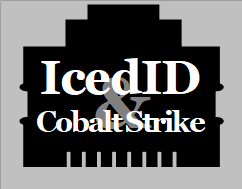
This network forensics walkthrough is based on two pcap files released byBrad Duncan onmalware-traffic-analysis.net. The traffic was generated by executing a malicious JS file called StolenImages_Evidence.js in a sandbox environment.
The capture file starts with a DNS lookup for banusdona.top, which resolved to 172.67.188.12, followed by an HTTP GET request for "/222g100/index.php" on that domain. The following PowerShell oneliner is returned in the HTTP response from banusdona.top:
This oneliner instructs the initial dropper to download a Win32 DLL payload from
As you can see in the screenshot below, the HTTP response for this second request to banusdona.top has Content-Type "application/octet-stream", but also a conflicting Content-disposition header of "attachment;filename=data.jpg", which indicates that the file should be saved to disk as "data.jpg". Nevertheless, the "MZ" header in the transferred data reveals that the downloaded data wasn't an image, but a Windows binary (dll or exe).
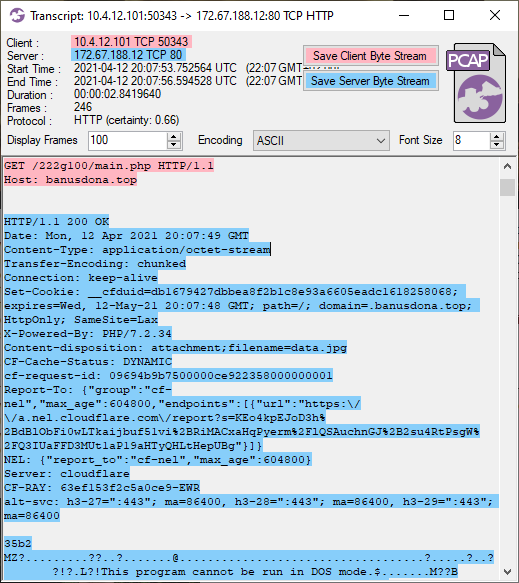 Image: CapLoader transcript of IcedID malware download
Image: CapLoader transcript of IcedID malware downloadThe downloaded file gets extracted from the pcap file by NetworkMiner as "data.jpg.octet-stream".
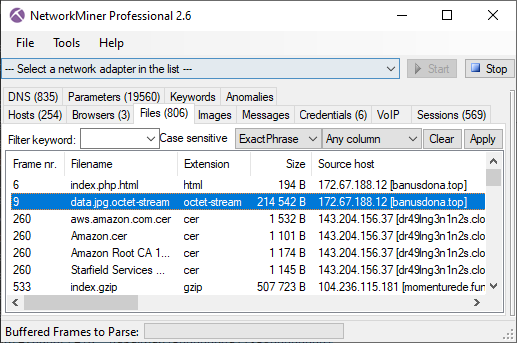 Image: Files extracted from PCAP by NetworkMiner
Image: Files extracted from PCAP by NetworkMinerRight-clicking "data.jpg.octet-stream" in NetworkMiner and selecting "Calculate MD5..." brings up a new window with additional file details, such as MD5 and SHA hashes of the reassembled file.
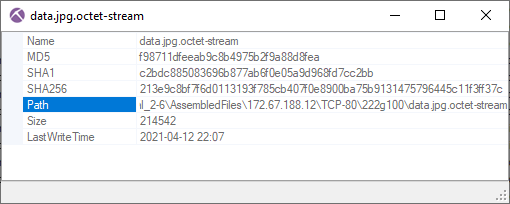
This file is available onVirusTotal, where we can see that it's a DLL that several AV vendors identify as "Cerbu" or "IcedID". VirusTotal's C2AE sandbox analysis of the DLL also reveals the domain name "momenturede.fun" in the process' memory. As you might expect, a connection is made to that domain just a few seconds later. A nice overview of these connections can be seen in CapLoader's Flow tab.
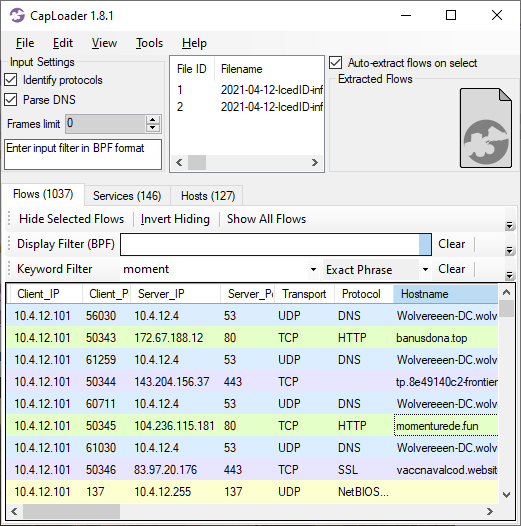 Image: CapLoader showing initial flows from the IcedID malware execution
Image: CapLoader showing initial flows from the IcedID malware executionThe momenturede.fun server returns a 500kB file, which NetworkMiner extracts from the pcap file as "index.gzip".
This turns out to be an encrypted IcedID DLL file, which has been analyzed byAli Aqeel here:
https://aaqeel01.wordpress.com/2021/04/09/icedid-analysis/
Right after the IcedID download we see a series of HTTPS connections towards odd domains like vaccnavalcod.website, mazzappa.fun, ameripermanentno.website and odichaly.space, all of which resolved to IP 83.97.20.176. That host is most likely a command-and-control (C2) server used by the IcedID malware.
CapLoader's "Services" tab also reveals that the TLS connections to port 443 on 83.97.20.176 are very periodic, with a new connection every 5 minutes. Periodic connection patterns like this is a typical indicator of C2 traffic, where the malware agent connects back to the C2 server on regular intervals to check for new tasks.
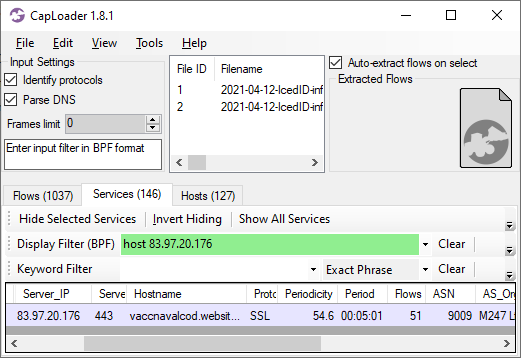 Image: CapLoader's Services tab showing that the IcedID malware agent connects to the C2 server every 5 minutes (00:05:01).
Image: CapLoader's Services tab showing that the IcedID malware agent connects to the C2 server every 5 minutes (00:05:01).The traffic to 83.97.20.176 is encrypted, so we can't inspect the payload to verify whether or not it is IcedID C2 communications. What we can do, however, is to extract the HTTPS server's X.509 certificate and the JA3 hash of the client's TLS implementation from the encrypted traffic.
NetworkMiner has extracted the X.509 certificates for vaccnavalcod.website, mazzappa.fun, ameripermanentno.website and odichaly.space to disk as "localhost.cer".
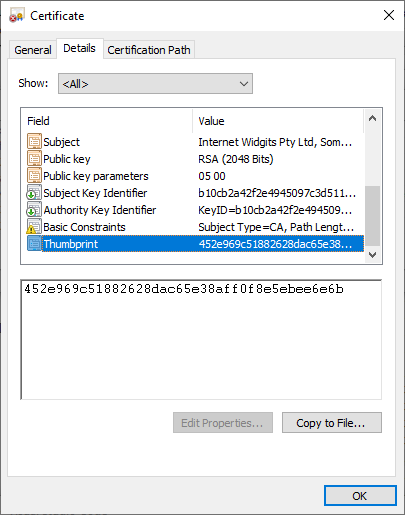
It turns out that all these sites used the same self-signed certificate, which had SHA1 fingerprint 452e969c51882628dac65e38aff0f8e5ebee6e6b. The X.509 certificate was created using OpenSSL's default values, such as "Internet Widgits Pty Ltd" etc. Further details about this certificate can be found oncensys.io.
The JA3 hash of the IcedID malware agent can be found in NetworkMiner's Hosts tab as well as in the Parameters tab.
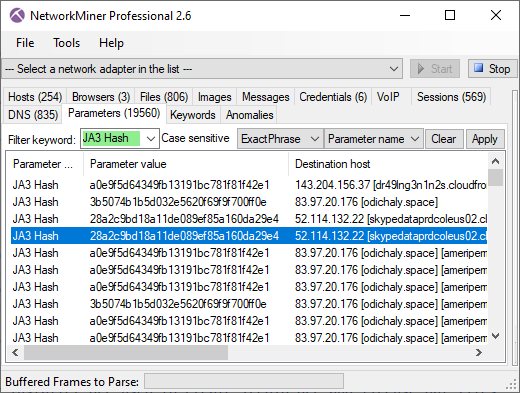 Image: NetworkMiner's Parameters tab with keyword filter "JA3 Hash"
Image: NetworkMiner's Parameters tab with keyword filter "JA3 Hash"The JA3 hash of the client that connects to those sites is 28a2c9bd18a11de089ef85a160da29e4. This hash isblacklisted by SSLBL, which is a project for detecting malicious SSL connections and SSL certificates used by botnet C2 servers.
The C2 traffic continues for over 19 hours, at which point we suddenly see a connection to a new suspicious domain called "lesti.net" on 185.141.26.140. The first HTTP request to that domain is used to download a 261703 byte file, as can be seen in this Flow Transcript from CapLoader:
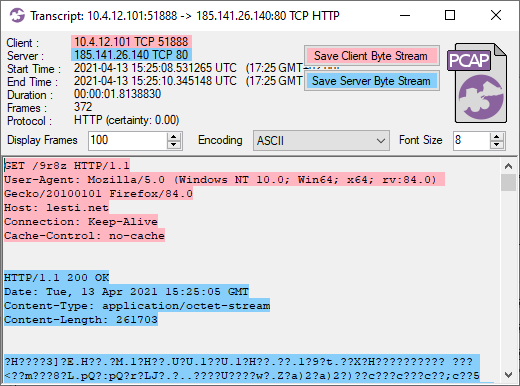
NetworkMiner extracts this file as "9r8z.octet-stream". This turns out to be a Cobalt Strike beacon download, which we can decode with Didier Stevens' fantastic1768.py script.
The output from 1768.py reveals that this Cobalt Strike beacon is using the following URIs for C2 communication:
- GET URI: http://lesti[.]net,/userid=
- POST URI: http://lesti[.]net/update.php
We can also see that the Cobalt Strike license-id (a.k.a. watermark) is 1580103814. This ID can be used to link this Cobalt Strike beacon to other campaigns, such asthis one identified byTek in December 2020, which uses the following C2 URIs:
- GET URI: https://45.147.229[.]157/match/
- POST URI: https://45.147.229[.]157/submit.php
Indicators of Compromise - IOCs
- MD5: 8da75e1f974d1011c91ed3110a4ded38
- SHA1: e9b5e549363fa9fcb362b606b75d131dec6c020e
- SHA256: 0314b8cd45b636f38d07032dc8ed463295710460ea7a4e214c1de7b0e817aab6
- DNS: banusdona.top
- IP: 172.67.188.12
- MD5: f98711dfeeab9c8b4975b2f9a88d8fea
- SHA1: c2bdc885083696b877ab6f0e05a9d968fd7cc2bb
- SHA256: 213e9c8bf7f6d0113193f785cb407f0e8900ba75b9131475796445c11f3ff37c
- DNS: momenturede.fun
- IP: 104.236.115.181
- MD5: 96a535122aba4240e2c6370d0c9a09d3
- SHA1: 485ba347cf898e34a7455e0fd36b0bcf8b03ffd8
- MD5: 11965662e146d97d3fa3288e119aefb2
- SHA1: b63d7ad26df026f6cca07eae14bb10a0ddb77f41
- SHA256: d45b3f9d93171c29a51f9c8011cd61aa44fcb474d59a0b68181bb690dbbf2ef5
- DNS: vaccnavalcod.website
- DNS: mazzappa.fun
- DNS: ameripermanentno.website
- DNS: odichaly.space
- IP: 83.97.20.176
- JA3: 28a2c9bd18a11de089ef85a160da29e4
- SHA1: 452e969c51882628dac65e38aff0f8e5ebee6e6b
- DNS: lesti.net
- IP: 185.141.26.140
- MD5: 449c1967d1708d7056053bedb9e45781
- SHA1: 1ab39f1c8fb3f2af47b877cafda4ee09374d7bd3
- SHA256: c7da494880130cdb52bd75dae1556a78f2298a8cc9a2e75ece8a57ca290880d3
- Cobalt Strike Watermark: 1580103814
Network Forensics Training
Are you interested in learning more about how to analyze captured network traffic from malware and hackers? Have a look at our network forensic trainings. Our next class is a live online event called PCAP in the Morning, which runs on May 3-6, 2021, between 8:30 AM and 12:30 PM EDT.
 Share on Facebook
Share on Facebook  Tweet
Tweet  Submit to reddit.com
Submit to reddit.com